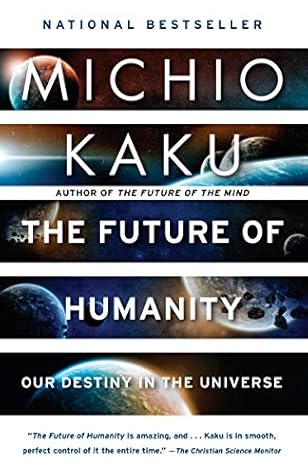More on this book
Community
Kindle Notes & Highlights
by
Michio Kaku
The grand history of life on Earth shows that, faced with a hostile environment, organisms inevitably meet one of three fates. They can leave that environment, they can adapt to it, or they will die.
Olaf Stapledon’s seminal novel Star Maker.
History reveals that scientific revolutions come in waves, often stimulated by advances in physics.
our destiny is to become the gods that we once feared and worshipped. Science will give us the means by which we can shape the universe in our image.
Robots can see—many times better than we can, in fact—but they don’t understand what they see.
as far back as 1863 by novelist Samuel Butler, who warned, “We are ourselves creating our own successors.
there is not a good track record of less intelligent things controlling things of greater intelligence.”
Claude Shannon, the father of information theory,
when he gazes into the heavens, he sometimes imagines that he might, in due course, witness evidence of superintelligent robots rearranging the stars.
Consciousness, I claim, is the process of creating a model of yourself using multiple feedback loops—for example, in space, in society, or in time—in order to carry out a goal.
I theorize that humans are different from animals because we understand time.
The latest part of the brain to evolve is the prefrontal cortex, which lies just behind our forehead. It is constantly running simulations of the future.
Within this framework, we can now define self-awareness, which can be understood as the ability to put ourselves inside a simulation of the future, consistent with a goal.
Goals do not magically arise in robots and instead must be programmed into them from the outside.
the 1921 play R.U.R., which first coined the word robot.
Next to the Hubble Space Telescope, the Kepler spacecraft is probably the most productive space satellite of all time.
heretical idea of migrating planets, which had been previously unheard of.
The next batch of giant telescopes in development, like the James Webb Space Telescope, might be able to capture the first photograph of the planet.
By one estimate, 85 percent of the stars in the Milky Way are red dwarfs.
The aeons involved in traversing the galaxy are not daunting to immortal beings. —SIR MARTIN REES, ASTRONOMER ROYAL OF ENGLAND
during the Middle Ages, master architects would design grand cathedrals knowing that they would not live long enough to see the completion of their masterpieces.
at least two hundred people per ship, in order to have a sustainable breeding population.
Nature uses glucose as an antifreeze,
This would be disastrous for life, since there would be giant earthquakes, monstrous tsunamis, and horrendous volcanic eruptions as the crust of the Earth began to crack.
It seems that an interplanetary war is about to break out, all because of a simple linguistic mistake.
The point is that animals do have primitive languages, and computers can mathematically calculate their complexity.
So our first encounter may not be with a bug-eyed monster but with a small self-replicating probe.
Von Neumann machines may be the most efficient way for a Type III civilization to obtain information concerning the state of the galaxy.
Only within the scaffolding of these truths, only on the firm foundation of unyielding despair, can the soul’s habitation henceforth be safely built.
Strangely, this means that even within our bodies there are vibrations within the space-time foam, but they are so tiny that we are blissfully unaware of them.


